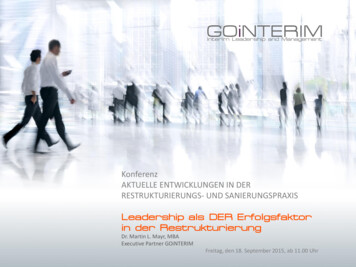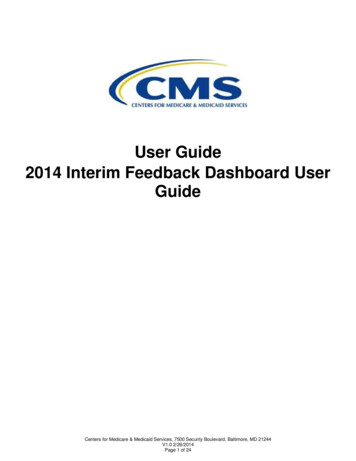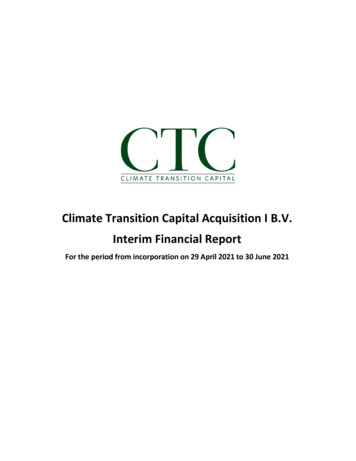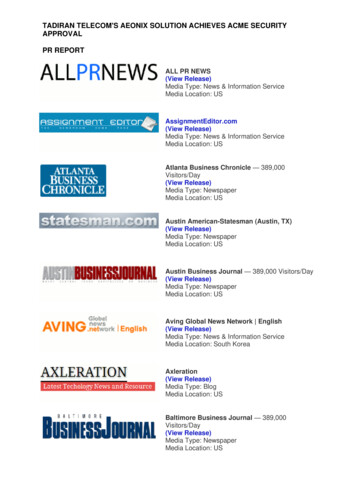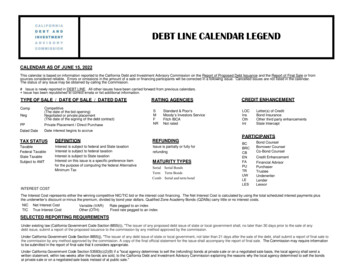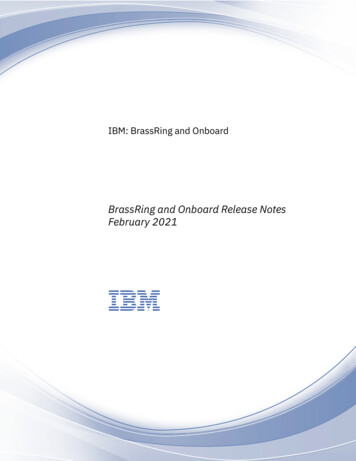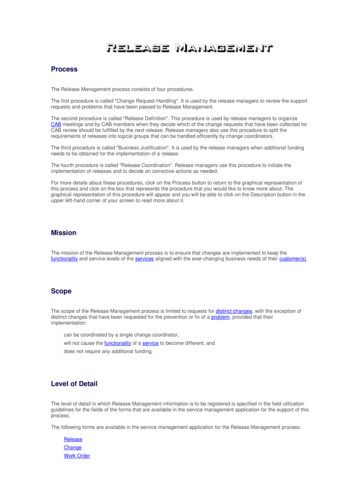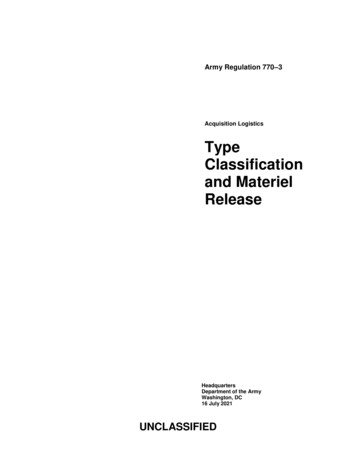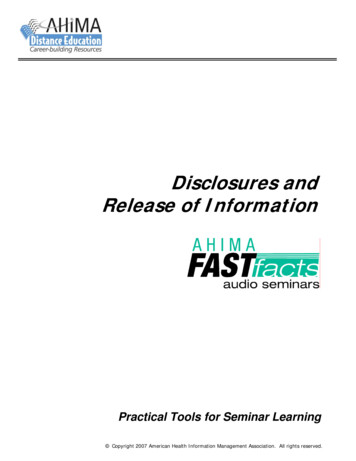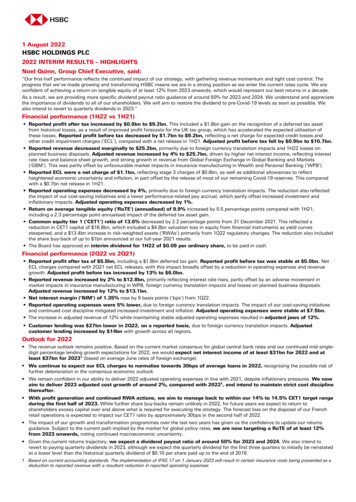
Transcription
1 August 2022HSBC HOLDINGS PLC2022 INTERIM RESULTS – HIGHLIGHTSNoel Quinn, Group Chief Executive, said:“Our first-half performance reflects the continued impact of our strategy, with gathering revenue momentum and tight cost control. Theprogress that we’ve made growing and transforming HSBC means we are in a strong position as we enter the current rates cycle. We areconfident of achieving a return on tangible equity of at least 12% from 2023 onwards, which would represent our best returns in a decade.As a result, we are providing more specific dividend payout ratio guidance of around 50% for 2023 and 2024. We understand and appreciatethe importance of dividends to all of our shareholders. We will aim to restore the dividend to pre-Covid-19 levels as soon as possible. Wealso intend to revert to quarterly dividends in 2023.”Financial performance (1H22 vs 1H21) Reported profit after tax increased by 0.8bn to 9.2bn. This included a 1.8bn gain on the recognition of a deferred tax assetfrom historical losses, as a result of improved profit forecasts for the UK tax group, which has accelerated the expected utilisation ofthese losses. Reported profit before tax decreased by 1.7bn to 9.2bn, reflecting a net charge for expected credit losses andother credit impairment charges (‘ECL’), compared with a net release in 1H21. Adjusted profit before tax fell by 0.9bn to 10.7bn. Reported revenue decreased marginally to 25.2bn, primarily due to foreign currency translation impacts and 1H22 losses onplanned business disposals. Adjusted revenue increased by 4% to 25.7bn, driven by higher net interest income, reflecting interestrate rises and balance sheet growth, and strong growth in revenue from Global Foreign Exchange in Global Banking and Markets(‘GBM’). This was partly offset by unfavourable market impacts in insurance manufacturing in Wealth and Personal Banking (‘WPB’). Reported ECL were a net charge of 1.1bn, reflecting stage 3 charges of 0.8bn, as well as additional allowances to reflectheightened economic uncertainty and inflation, in part offset by the release of most of our remaining Covid-19 reserves. This comparedwith a 0.7bn net release in 1H21. Reported operating expenses decreased by 4%, primarily due to foreign currency translation impacts. The reduction also reflectedthe impact of our cost-saving initiatives and a lower performance-related pay accrual, which partly offset increased investment andinflationary impacts. Adjusted operating expenses decreased by 1%. Return on average tangible equity (‘RoTE‘) (annualised) of 9.9% increased by 0.5 percentage points compared with 1H21,including a 2.3 percentage point annualised impact of the deferred tax asset gain. Common equity tier 1 (‘CET1’) ratio of 13.6% decreased by 2.2 percentage points from 31 December 2021. This reflected areduction in CET1 capital of 16.8bn, which included a 4.8bn valuation loss in equity from financial instruments as yield curvessteepened, and a 13.4bn increase in risk-weighted assets (‘RWAs’) primarily from 1Q22 regulatory changes. The reduction also includedthe share buy-back of up to 1bn announced at our full-year 2021 results. The Board has approved an interim dividend for 1H22 of 0.09 per ordinary share, to be paid in cash.Financial performance (2Q22 vs 2Q21) Reported profit after tax of 5.8bn, including a 1.8bn deferred tax gain. Reported profit before tax was stable at 5.0bn. NetECL charges compared with 2Q21 net ECL releases, with this impact broadly offset by a reduction in operating expenses and revenuegrowth. Adjusted profit before tax increased by 13% to 6.0bn. Reported revenue increased by 2% to 12.8bn, primarily reflecting interest rate rises, partly offset by an adverse movement inmarket impacts in insurance manufacturing in WPB, foreign currency translation impacts and losses on planned business disposals.Adjusted revenue increased by 12% to 13.1bn. Net interest margin (‘NIM’) of 1.35% rose by 9 basis points (‘bps’) from 1Q22. Reported operating expenses were 5% lower, due to foreign currency translation impacts. The impact of our cost-saving initiativesand continued cost discipline mitigated increased investment and inflation. Adjusted operating expenses were stable at 7.5bn. The increase in adjusted revenue of 12% while maintaining stable adjusted operating expenses resulted in adjusted jaws of 12%. Customer lending was 27bn lower in 2Q22, on a reported basis, due to foreign currency translation impacts. Adjustedcustomer lending increased by 14bn with growth across all regions.Outlook for 2022 The revenue outlook remains positive. Based on the current market consensus for global central bank rates and our continued mid-singledigit percentage lending growth expectations for 2022, we would expect net interest income of at least 31bn for 2022 and atleast 37bn for 20231 (based on average June rates of foreign exchange). We continue to expect our ECL charges to normalise towards 30bps of average loans in 2022, recognising the possible risk offurther deterioration in the consensus economic outlook. We remain confident in our ability to deliver 2022 adjusted operating expenses in line with 2021, despite inflationary pressures. We nowaim to deliver 2023 adjusted cost growth of around 2%, compared with 20221, and intend to maintain strict cost disciplinethereafter. With profit generation and continued RWA actions, we aim to manage back to within our 14% to 14.5% CET1 target rangeduring the first half of 2023. While further share buy-backs remain unlikely in 2022, for future years we expect to return toshareholders excess capital over and above what is required for executing the strategy. The forecast loss on the disposal of our Frenchretail operations is expected to impact our CET1 ratio by approximately 30bps in the second half of 2022. The impact of our growth and transformation programmes over the last two years has given us the confidence to update our returnsguidance. Subject to the current path implied by the market for global policy rates, we are now targeting a RoTE of at least 12%from 2023 onwards, noting continued macroeconomic uncertainty. Given the current returns trajectory, we expect a dividend payout ratio of around 50% for 2023 and 2024. We also intend torevert to paying quarterly dividends in 2023, although we expect the quarterly dividend for the first three quarters to initially be reinstatedat a lower level than the historical quarterly dividend of 0.10 per share paid up to the end of 2019.1 Based on current accounting standards. The implementation of IFRS 17 on 1 January 2023 will result in certain insurance costs being presented as adeduction to reported revenue with a resultant reduction in reported operating expenses
Key financial metricsHalf-year to30 Jun30 Jun31 ,2158,2898,4227,2766,2715,331Cost efficiency ratio (%)Net interest margin (%)165.11.3066.91.2173.11.20Basic earnings per share ( )Diluted earnings per share ( )0.420.410.360.360.260.26Alternative performance measuresAdjusted revenue ( m)25,69024,73423,577Adjusted profit before tax ( m)10,67311,5389,681Adjusted cost efficiency ratio (%)59.962.765.5Expected credit losses and other credit impairment charges (‘ECL’) (annualised) as % of average gross loans andadvances to customers (%)0.21(0.14)(0.03)Reported resultsReported revenue ( m)Reported profit before tax ( m)Reported profit after tax ( m)Profit attributable to the ordinary shareholders of the parent company ( m)Return on average ordinary shareholders’ equity (annualised) (%)19.78.47.1Return on average tangible equity (annualised) (%)1,29.99.48.330 Jun30 Jun31 ance sheetTotal assets ( m)Net loans and advances to customers ( m)Customer accounts ( m)Average interest-earning assets ( m)Loans and advances to customers as % of customer accounts (%)Total shareholders’ equity ( m)Tangible ordinary shareholders’ equity ( m)Net asset value per ordinary share at period end ( )Tangible net asset value per ordinary share at period end ( )Capital, leverage and liquidityCommon equity tier 1 capital ratio (%)3,4Risk-weighted assets ( m)3,4Total capital ratio (%)3,4Leverage ratio (%)3,4High-quality liquid assets (liquidity value) ( bn)4Liquidity coverage ratio (%)4Share countPeriod end basic number of 0.50 ordinary shares outstanding (millions)Period end basic number of 0.50 ordinary shares outstanding and dilutive potential ordinary shares (millions)Average basic number of 0.50 ordinary shares outstanding (millions)Dividend per ordinary share (in respect of the period) ( )For reconciliations of our reported results to an adjusted basis, including lists of significant items, see page 37 of the Interim Report 2022.Definitions and calculation of other alternative performance measures are included in our ‘Reconciliation of alternative performancemeasures’ on page 56 of the Interim Report 2022.1 For these metrics, half-year to 31 December 2021 is calculated on a full-year basis and not a 2H21 basis.2 Profit attributable to ordinary shareholders, excluding impairment of goodwill and other intangible assets and changes in present value of in-forceinsurance contracts (‘PVIF’) (net of tax), divided by average ordinary shareholders’ equity excluding goodwill, PVIF and other intangible assets (net ofdeferred tax).3 Unless otherwise stated, regulatory capital ratios and requirements are based on the transitional arrangements of the Capital RequirementsRegulation in force at the time. These include the regulatory transitional arrangements for IFRS 9 ‘Financial Instruments’, which are explained furtheron page 94 of the Interim Report 2022. The leverage ratio is calculated using the end point definition of capital and the IFRS 9 regulatory transitionalarrangements, in line with the UK leverage rules that were implemented on 1 January 2022, and excludes central bank claims. Comparatives for2021 are reported based on the disclosure rules in force at that time, and include claims on central banks. References to EU regulations anddirectives (including technical standards) should, as applicable, be read as references to the UK’s version of such regulation and/or directive, asonshored into UK law under the European Union (Withdrawal) Act 2018, and subsequently amended under UK law.4 Regulatory numbers and ratios are as presented at the date of reporting. Small changes may exist between these numbers and ratios and thosesubsequently submitted in regulatory filings. Where differences are significant, we will restate comparatives.2HSBC Holdings plc 2022 Interim Results
HighlightsHalf-year toReportedRevenue1Change in expected credit losses and other credit impairment chargesOperating expenses30 Jun30 Jun20222021 m m25,23625,551(1,090)(16,419)719(17,087)Share of profit in associates and joint venturesProfit before tax1,4499,1761,65610,839Tax (expense)/creditProfit after tax399,215(2,417)8,422Adjusted2Revenue1,3Change in expected credit losses and other credit impairment chargesOperating expensesShare of profit in associates and joint venturesProfit before taxTax (expense)/creditProfit after 5)(153)—Significant items affecting adjusted performanceRevenueCustomer redress programmesDisposals, acquisitions and investment in new businesses3Fair value movements on financial instruments4Restructuring and other related costs5Operating expensesCustomer redress programmesImpairment of goodwill and other intangiblesRestructuring and other related costsTax expense/(credit)Tax charge/(credit) on significant itemsRecognition of losses on HSBC Holdings1 Net operating income before change in expected credit losses and other credit impairment charges, also referred to as revenue.2 Adjusted performance is computed by adjusting reported results for the period-on-period effects of foreign currency translation differences andsignificant items which distort period-on-period comparisons.3 Includes losses from classifying businesses as held-for-sale as part of a broader restructuring of our European business.4 Includes fair value movements on non-qualifying hedges and debt valuation adjustments on derivatives.5 Comprises losses associated with the RWA reduction commitments and gains we made at our business update in February 2020.HSBC Holdings plc 2022 Interim Results3
Review by Noel Quinn, Group Chief ExecutiveWe are now two and a half years into our transformation programme to make HSBC fit for the future. We still have more work to do in thesecond half of this year – but we are now much better positioned to meet the needs of our international customers and to deliver higherreturns for our shareholders.The key to delivering our ambitions, now and in the future, is to grow and transform HSBC at the same time. That was the focus of thetransformation programme we announced in February 2020, and of the updated strategy we launched in February 2021. The progress wehave made in both regards gives us a strong starting point as we enter the current interest rate cycle.Our transformation agenda has been based around three things: reshaping our portfolio, increasing our capital efficiency and tightlymanaging our costs. In 2021, we accelerated this agenda in response to Covid-19, under four strategic pillars: focus on our strengths,digitise at scale, energise for growth, and lead the transition to net zero.In reshaping our portfolio, we have exited – or are exiting – non-strategic businesses in the West and reallocated capital towards areas ofgrowth in Asia and the Middle East. In the first half of 2022, we completed our acquisition of AXA Singapore, increased our stake in HSBCQianhai Securities to 90%, took full ownership of our HSBC Life China insurance business, and agreed to sell our businesses in Greece andRussia, subject to regulatory approvals.In terms of capital efficiency, our risk-weighted asset reduction programme had reached 104bn by the end of 2021, against a target of 110bn by the end of 2022. We have now reached a cumulative total of 114bn of risk-weighted asset savings, and the acceleration ofrestructuring across our US and Europe businesses means we are on track to reach at least 120bn of savings by the end of this year.We continue to invest in areas of strength. Our investment to boost our Asia wealth product and platform capabilities helped us to attractstrong levels of net new invested assets, and to grow the value of new business in our insurance franchise in Asia by 41% on last year’sfirst-half. We achieved both of these despite the temporary closure of parts of our branch network due to Covid-19 restrictions in HongKong.Finally, we have continued to manage our cost base with discipline. Our sustained investment to digitise HSBC at scale has helped make usa more agile and efficient organisation. Our hybrid working model has enabled us to reduce our office real estate footprint by around a thirdsince the start of 2020. At the same time, rising customer demand for digital products and services has enabled us to keep reducing andadapting our branch network in response to changing customer behaviour.Our cost reduction programmes remain on track. We have more to do before December – particularly to further simplify the organisation –but I remain committed to achieving stable adjusted costs in 2022 compared with last year, despite rising inflation.InternationalAs a result of this work, HSBC is now a more international business, focused on serving international customers alongside our strongdomestic franchises in Hong Kong and the UK. Serving customers across borders is what we do best. It is how we can best help them togrow, and, we believe, the fastest way to accelerate returns for our shareholders.HSBC has been internationally focused since it was founded 157 years ago to support trade between East and West. When we refreshedour purpose 18 months ago, we spoke to tens of thousands of our customers, colleagues and other stakeholders as we considered who weare and what we do. Our refreshed purpose – ‘opening up a world of opportunity’ – underlined that our internationalism remains the mostdefining characteristic of our identity.Our strength as a well connected, global institution is the main reason our wholesale clients choose to bank with us and we are determinedto capitalise on the advantages our network gives us. As part of this, we are exiting domestic wholesale client relationships where returnsare sub-standard in order to focus on meeting the needs of international customers. We have repositioned our US and Europe businesses inthe same vein, completing the sale of our US domestic mass market retail business in the first half of the year, and remaining on track tocomplete the sale of our French retail business in 2023.This strategy is serving our customers and investors well. Even as trade flows have changed and supply chains have shifted post-pandemic,we have maintained our leadership in global trade because our global network means we can go wherever trade goes. We built on thisfurther in the first-half, growing trade balances by 5bn or 6% in a challenging global environment. We were also named ‘Best Bank forTrade Finance’ by Euromoney in July.In a low interest-rate environment, our international network was also a key factor in the good returns generated by our other leadingfranchises. More than three quarters of our wholesale client revenue is connected to our international network, and just under half of ourwholesale client business is cross-border. Our ability to connect clients in the West with high-returning opportunities in the East remains akey differentiator.In Commercial Banking, adjusted revenue grew by 14% compared with last year’s first-half, with international business a strong contributor.In particular, we saw adjusted revenue growth of 20% in Global Trade and Receivables Finance, and of 42% in Global Liquidity and CashManagement.In Global Banking and Markets, adjusted revenue was up 4% on the same period last year, due in part to a good performance in transactionbanking. In addition, the volume of client business booked in Asia and the Middle East from clients managed in Europe and the Americasgrew by 8% on last year’s first-half, underlining the importance of our ability to connect global clients and investors to those regions.In Wealth and Personal Banking, we grew the number of customers classed as international by 5%, compared with last year’s first-half.These include customers we bank in more than one market, and customers who come from a country or territory other than the market inwhich they now bank. According to our analysis, the average international customer generates around double the revenue of the averagedomestic customer. This is both our fastest growing customer segment, and our most commercially attractive.Financial performanceOur first-half performance reflected much of the progress we have made since 2020, with good organic growth across the business andtight cost control. In addition, increased net interest income reflected rising global interest rates, with further policy rate rises anticipatedover the coming months.Overall, the Group delivered 9.2bn of reported profit before tax and 10.7bn of adjusted profit before tax in the first half of the year.Although this was lower than in the first half of 2021, it reflected a more normalised level of expected credit losses compared with theCovid-19 releases made last year, as well as the macroeconomic impact of the Russia-Ukraine war.4HSBC Holdings plc 2022 Interim Results
All our regions were profitable in the first-half. This included a strong performance from HSBC UK, which delivered adjusted profits of 2.5bn, up 15% on the first half of last year. Our Asia business delivered adjusted profits of 6.3bn, despite the impact of Covid-19 in someof our biggest markets.Adjusted revenue was up 4%, including growth of 15% in net interest income compared with last year’s first-half. Market impacts meantwealth revenue was lower compared with the same period last year, although our insurance business performed well. In CommercialBanking, adjusted trade revenue was up 20% on the prior year. Lending balances were up in all businesses in the first-half, underlining thatconversion of our business pipelines remains strong.Adjusted operating expenses fell by 1%, mainly as a result of our cost-saving initiatives and a lower performance-related pay accrual. Weachieved this in spite of growing inflationary pressures and rising investments in technology and our Asia Wealth business.Our CET1 ratio at the end of the first-half was 13.6%, down from 15.8% at the end of 2021. This reflected losses on financial instrumentsheld as hedges to our exposure to interest rate movements, and an increase in RWAs due to regulatory changes and foreign exchangemovements. We expect to be back within our 14% to 14.5% CET1 target range in the first half of 2023.We have announced an interim dividend of 0.09 per share, up 0.02 per share on the first half of 2021. We have also now completed boththe 2bn buy-back programme we announced in 2021, and the further 1bn buy-back we announced at our annual results in February.OutlookThe revenue outlook has improved further since our full-year 2021 results, despite the uncertain macroeconomic environment.In February, based on the implied market consensus policy rates at the time, we expected to deliver a return on tangible equity of at least10% for 2023. We expect to make further progress with our growth and transformation plans in the second half of 2022, and believe we canrestrict cost growth to around 2% in 2023, despite inflationary pressures. Subject to the path currently being implied by the market for policyrates, we are now confident of achieving a return on tangible equity of at least 12% from 2023 onwards.As a result of this higher returns trajectory, we are also able to provide more specific guidance around dividends. We now expect to deliveran improved payout ratio of around 50% for 2023 and 2024, subject to achieving our performance targets. We also intend to revert topaying quarterly dividends from the start of 2023. We remain committed to enabling our shareholders to benefit from the growing returnsthat our strategy is delivering.Transition to net zeroThe transition to net zero is a core part of our strategy, both now and for the long term. Given our scale and footprint, we know we have amajor role to play in enabling the transition to a net zero global economy. I am unequivocal about my own personal commitment to thisagenda, and that commitment is shared by the Board and the senior management team. The urgent need to transition the global economyto net zero is going to change the industrial landscape completely. The overwhelming majority of our clients understand this, and areactively planning and undertaking their own transitions. It stands to reason that financing the new business models and climatetechnologies they need presents a huge commercial opportunity for HSBC.I am pleased that we have continued to make good progress towards our ambition of providing and facilitating between 750bn and 1tn ofsustainable finance and investment by 2030. By the end of June, our cumulative total for sustainable finance and investment since 2019 wasmore than 170.8bn. Earlier this year, we published interim targets for on-balance sheet financed emissions in the oil and gas, and powerand utilities sectors. We also committed to publish our first bank-wide climate transition plan in 2023, to phase down fossil fuel financing inline with science-based targets, and to review and update our financing and investment policies critical to net zero. These concrete actionscan have a significant impact in reducing global emissions and will help ensure that HSBC remains a global climate leader.Our peopleEverything we have achieved over the last six months – and everything we want to achieve over the next six months and beyond – rests onthe hard work, commitment and tireless efforts of my colleagues around the world.I am especially grateful to my colleagues for managing considerable uncertainty and disruption in the first half of the year, particularly thosein Hong Kong and mainland China, who have managed the impact of Covid-19 restrictions on our customers and communities; in Sri Lanka,who have continued to deliver for our customers during the current economic and political crisis; and in Poland and eastern Europe, whohave been volunteering to help those directly impacted by the Russia-Ukraine war.I am grateful too for the support that my colleagues have offered to customers impacted by the ongoing cost of living crisis gripping manyof the world’s major economies. These are testing times for many of those who bank with us and we are committed to helping supportthem through this difficult period.My colleagues represent the very best of HSBC, and I am proud of all they have done – and are doing – to support our customers,communities and each other.Noel QuinnGroup Chief Executive1 August 2022HSBC Holdings plc 2022 Interim Results5
Financial summaryHalf-year toFor the periodProfit before taxProfit attributable to:– ordinary shareholders of the parent companyDividends on ordinary shares1At the period endTotal shareholders’ equityTotal regulatory capitalCustomer accountsTotal assetsRisk-weighted assetsPer ordinary shareBasic earningsDividend per ordinary share (paid in the period)1Net asset value230 Jun30 Jun31 Dec2022 m2021 m2021 957,939838,263 0.420.188.410.360.158.690.260.078.761 Second interim dividend of 0.18 per ordinary share in respect of the financial year ending 31 December 2021, paid in April 2022.2 The definition of net asset value per ordinary share is total shareholders equity, less non-cumulative preference shares and capital securities, dividedby the number of ordinary shares in issue, excluding own shares held by the company, including those purchased and held in treasury.Distribution of results by global businessAdjusted profit before taxHalf-year to30 Jun 2022Wealth and Personal BankingCommercial BankingGlobal Banking and MarketsCorporate CentreProfit before tax30 Jun 202131 Dec 2021 m% m% tion of results by geographical regionReported profit/(loss) before taxHalf-year to30 Jun 202130 Jun 2022EuropeAsiaMiddle East and North AfricaNorth AmericaLatin AmericaProfit before tax6HSBC Holdings plc 2022 Interim Results31 Dec 2021 m% 6,93672380540710,83918.264.06.77.43.7100.0 .0
HSBC adjusted profit before tax and balance sheet dataHalf-year to 30 Jun 2022Wealth andPersonalBankingCommercialBankingGlobalBanking andMarketsCorporateCentreTotal m m m m mNet operating income/(expense) before change in expected credit losses andother credit impairment charges110,9227,2177,841(290)25,690– �3,578—2,879– inter-segmentof which: net interest income/(expense)Change in expected credit losses and other credit impairment (charges)/recoveriesNet operating income/(expense)Total operating expensesOperating profit/(loss)Share of profit in associates and joint venturesAdjusted profit before tax1,4411,2701,44910,673%%%%%Share of HSBC’s adjusted profit before tax27.633.527.011.9100.0Adjusted cost efficiency ratioAdjusted balance sheet data67.946.460.441.759.9 m m m m mLoans and advances to customers (net)Interests in associates and joint 8,35629,446Total external assetsCustomer accountsAdjusted risk-weighted 51,301851,743Half-year to 30 Jun 2021Net operating income before change in expected credit losses and other creditimpairment charges110,9806,3537,518(117)24,734– external– inter-segmentof which: net interest income/(expense)Change in expected credit losses and other credit impairment (charges)/recoveriesNet operating income/(expense)Total operating expensesOperating profit/(loss)Share of profit in associates and joint venturesAdjusted profit before 91,64911,538Share of HSBC’s adjusted profit before taxAdjusted cost efficiency ratioAdjusted balance sheet dataLoans and advances to customers (net)Interests in associates and joint venturesTotal external assetsCustomer accountsAdjusted risk-weighted .062.7 m m m m 942818,9461 Net operating income before change in expected credit losses and other credit impairment charges, also referred to as revenue.2 Ad
fair value through profit or loss (3,051) 2,795 1,258 Change in fair value of designated debt and related derivatives (158) (67) (115) Changes in fair value of other financial instruments mandatorily measured at fair value through profit or loss 68 548 250 Gains less losses from financial investments 21 433 136
